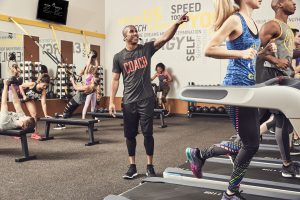By Alexandra Black Larcom MPH, RD, LDN, Senior Manager of Health Promotion & Health Policy at IHRSA
During the month of January, health and fitness is top of mind for people setting resolutions for a healthy new year. Google searches for fitness peak at the beginning of the year (Figure 1), and according to data from the International Health, Racquet, and Sportsclub Association (IHRSA), 10.8 percent of all health club members join their gyms in January. Yet many who embark on fitness resolutions in the new year struggle to stick with their new habit, and as many as 80 percent of resolutions fail by February.

While health professionals can’t completely guarantee the success of their patients or clients, there are a few things we can do to set them up for success as they seek to adopt a new exercise habit. Studies have identified several factors linked to better exercise adherence in various groups of people. Here we present five factors that we can use to help patients and clients stick to their resolutions all year long.
Enjoyment
The best type of physical activity is the one you’ll keep doing. One study found that among previously inactive people with obesity who tried high-intensity functional training, those who enjoyed the exercise at baseline were more likely to stick with it and to continue doing similar exercise after the study. Health professionals should encourage patients and clients to try different types and combinations of physical activity until they find something they enjoy. People should also feel comfortable exploring different types of physical activity if they get bored with something. It’s important to note that the type of exercise or physical activity someone prefers is not as important as how much time they regularly spend performing that exercise. The Physical Activity Guidelines for Americans recommends adults get at least 150 minutes of moderate-to-vigorous aerobic physical activity each week, along with at least two days of muscle-strengthening activity for health benefits.
Self-efficacy
Aside from time and cost, intimidation and lack of knowledge about what to do in a gym are commonly cited as barriers to exercise and reasons for quitting. In a study of people with coronary artery disease, both self-directed motivation and self-efficacy were important determinants of short-term (6-month) exercise adherence. To boost self-efficacy, people can seek support from gym staff, a personal trainer, or friends, to build their knowledge around exercise technique and workout structures. People can also seek online resources from certified fitness professionals with instructions, videos, and templates. Group fitness is another way to build self-efficacy. Learning yoga, weight lifting, cycling, or functional training in a coached group setting can better prepare people to be active on their own and feel confident in doing so.
Social support
It is often easier to stick to a habit or behavior when your social and family network is supportive. In a study of 100 middle-aged and older adults, social support—in addition to pain and perceived benefits of exercise—predicted adherence to a 12-month, at-home exercise program. It is important for people to build – and health professionals to encourage and facilitate – social support for physical activity. People can do this by inviting friends and family to join in the new exercise habit and/or seeking out new social opportunities with people who share an interest in the same activities. Health professionals can encourage partner or group workouts, or refer them to walking or other active groups in the community. People are a lot more likely to stick with exercise if their friends are there too.
Accountability

Along with support, accountability can also be a motivating factor for many. A qualitative study with a group of middle-aged women indicated that accountability was one of several factors that enabled exercise. Research has shown that people who exercise in groups are more likely to see results. People can establish accountability by working out with a friend or two, or a coach. Sharing their exercise journey online can also build accountability. For instance, if someone posts on Facebook about going to the gym, he or she might be more likely to actually go.
Integration into the daily routine
Lack of time is often cited as a barrier to physical activity, but it doesn’t have to be. Planning ahead is a great way to help overcome this barrier. In the same study of women mentioned in the previous section, having a daily routine that incorporated physical activity also helped enable regular exercise. Health professionals can encourage patients and clients to schedule weekly workouts in their calendar to make sure it fits into their day. Workouts can also be broken up into smaller blocks to better fit into the day. For example, someone could spend one hour in the gym, or they could spend 30 minutes in the gym and take two 15-minute brisk walks throughout the day.
Taking up a physical activity habit can be challenging, but health professionals can encourage people to find activities that they enjoy, build skills and confidence safely, find social support and accountability, and fit physical activity into their daily routine. These practices can help new fitness enthusiasts stick to their New Year’s resolutions for years to come.
Spread the Word! Share this post with your network using this sample tweet: Sticking to New Year’s Resolutions is tough – only about 20% of people succeed. These five factors from @IHRSA_GetActive can help people stick to their Resolutions year round. Check them out on the BAYW blog: http://bit.ly/2Dd15xK